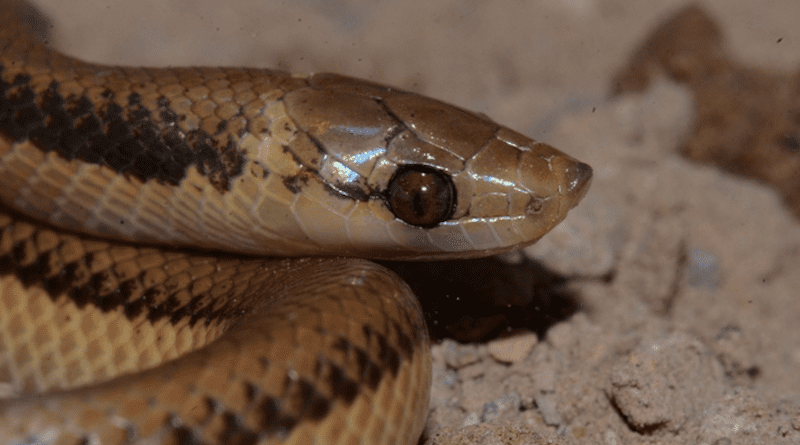Snakes Distributed In The Chaco In Accordance With Adaptations To Environment
Despite similarities with other Neotropical biomes like the Caatinga (a mosaic of scrub with patches of seasonally dry forest in Northeast Brazil) and Cerrado (savanna in Central Brazil), the Gran Chaco, or simply Chaco, is globally unique. Located mainly in Bolivia and Argentina, with patches in Brazil and Paraguay, the region is the world’s largest continuous dry tropical forest. Snakes must adapt in various ways to survive there. Sheltering from the sun and climbing trees are examples.
In an article published in the journal Ecology and Evolution, researchers affiliated with institutions in Brazil and Paraguay report the results of a study according to which the distribution of snake species in the Chaco correlates closely with the adaptations that have occurred during their evolution.
“In the south, which is drier, most species are fossorial [living primarily underground], while in the north, which is influenced by the Amazon and other rainforests, snakes are mainly arboreal [tree dwellers]. The differences are evidenced by their morphology [body shapes],” said Hugo Cabral, first author of the article. Cabral, a Paraguayan-born researcher, conducted the study as a PhD candidate at São Paulo State University’s Institute of Biosciences, Letters and Exact Sciences (IBILCE-UNESP) in São José do Rio Preto (Brazil).
The study showed that most species in the northern portion of the Chaco ecoregion tend to have long tails, which can correspond to almost half their total length. This means they are arboreal or semi-arboreal, with prehensile tails that can grip tree branches or other objects.
Nearer the Amazon, the Andean Forest and Chiquitania, a region of tropical savanna in eastern Bolivia, the northernmost part of the Chaco is also wetter, with considerable diversity of tree species that are home to snakes that have adapted to live above ground.
In the southern part, species are shorter overall with shorter tails and have small eyes, all of which means they are fossorial or semi-fossorial. Living underground is an adaptation that enables them to survive the high temperatures in this part of the Chaco, which can reach 48° C. The soil is sandy there, so that the snakes can easily dig burrows.
“One of the questions we had in mind was whether snake species were distributed homogeneously throughout the Chaco. The analysis showed they weren’t. Their distribution is closely linked to habitat, and entire evolutionary groups are often found in the same area, reflecting the selective pressure exerted by the environment,” said Thaís Guedes, a co-author of the article and a researcher at the State University of Campinas’s Institute of Biology (IB-UNICAMP) with a scholarship from FAPESP.
Guedes is principal investigator for the project “Evolution and biogeography of the herpetofauna: patterns, process and implications for conservation in a scenario of environmental and climate changes”, with funding from FAPESP.
The results were obtained by computational analysis of a database with ecological and morphological data for 140 species that live in the Chaco. Ecological data included information on habitat (aquatic, terrestrial, arboreal, semi-arboreal, fossorial, semi-fossorial). Morphological data included information on snout-vent length, tail length, total length, body mass and eye diameter (large or small). The data was superimposed on a map of species distribution in the Chaco and cross-referenced with environmental variables that can select for vertical niches, relating to climate, vegetation and soil sandiness.
Little known region
“Tropical forests occupy a very large part of South America and partly for this reason relatively little is known about other ecosystems on the continent, such as the Chaco, which boasts huge biodiversity,” said the other co-author of the article, Diego José Santana, a professor at the Federal University of Mato Grosso do Sul (UFMS) and at IBILCE-UNESP, where he teaches animal biology to graduates and supervised Cabral’s doctoral research.
Like the Caatinga, the Chaco is neglected in studies on biodiversity. Moreover, in recent decades the region has suffered from high rates of deforestation. Understanding ecological and evolutionary processes is therefore increasingly relevant, Cabral said, adding that the few existing studies analyze the northern and southern parts of the Chaco separately. This is the first time it has been investigated in its entirety. “Species don’t care about borders. A broader, more integrated approach is needed,” he reiterated.
For Guedes, research like this provides important guidance for more efficient conservation strategies. For example, when planning the creation of one or more protected areas, it is now possible to define locations that contain not only the largest number of species, especially if they are endemic, but also the largest diversity of evolutionary histories.
“We know we probably won’t be able to protect the entire biome, but we have enough information to help define areas with the most potential to safeguard as many groups of species as possible,” she said.

